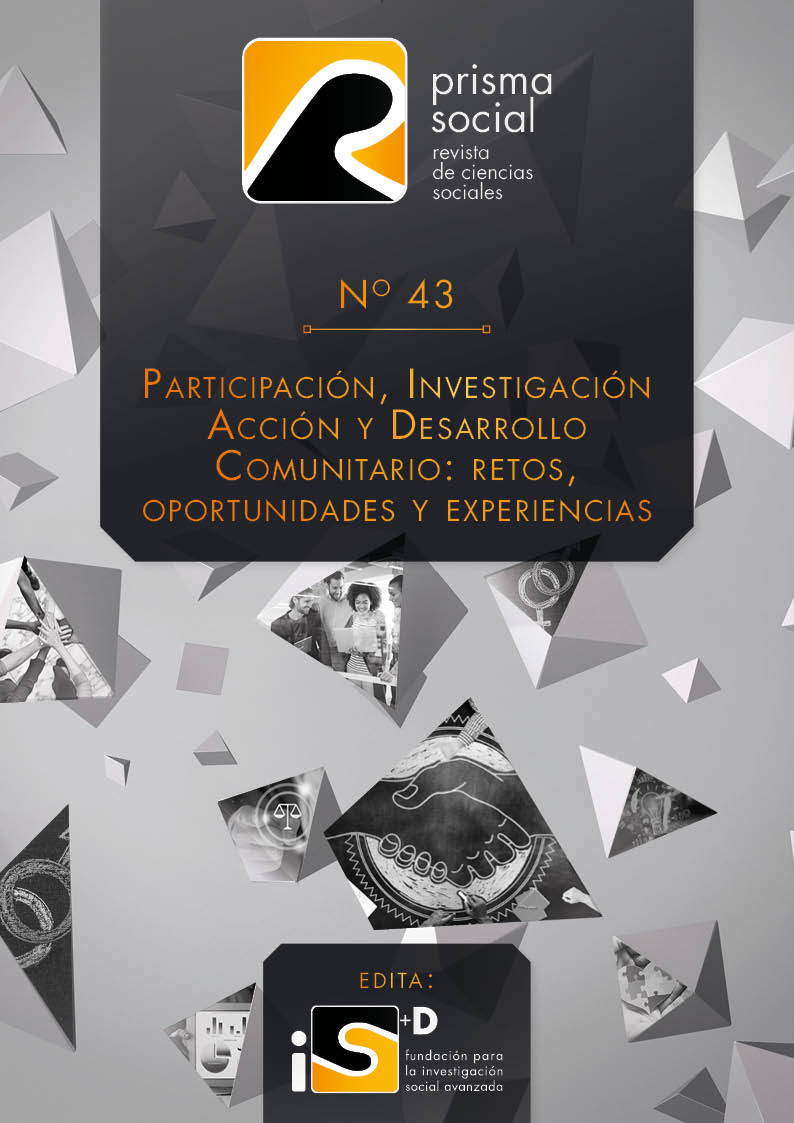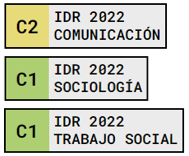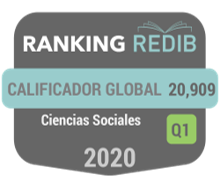Social discourse on cyberbullying in the digital press
An analysis for social intervention professionals
Palabras clave:
Cyberbullying, qualitative method, COVID-19, Social Work, digital pressResumen
Given the influence of the mass media on constructing realities and opinions, we investigated how the phenomenon of cyberbullying is presented in the digital versions of the high-profile newspapers El País and El Mundo.
A qualitative method was used. In the first stage, thematic analysis was applied to the textual content of the selected news items. Three themes were obtained:1: Metamorphosis of school bullying: the emergence of cyberbullying; 2: Patriarchy in cyberbullying: gender issues; and 3: The COVID-19 pandemic: a breeding ground for cyberbullying. In the second stage, discursive analysis was conducted to study in further depth the interconnected contents found in the three themes. The following IR was obtained: An incipient prevention-intervention approach against cyberbullying.
The results suggest that there is a pressing need to plan and implement systematic and well-coordinated measures. To do so, special emphasis must be placed on sensitizing society in general and social intervention professionals in particular to these new ways of exercising violence such that they support and contribute socially to this initiative. As part of their political agendas, all the institutions involved should prioritize the struggle against the current scourge of cyberbullying.
Descargas
Citas
Agatston, P., & Limber, S. (2018). Cyberbullying Prevention and Intervention: Promising Approaches and Recommendations for Further Evaluation. En J. U’Mofe (Ed.), Bullying Prevention and Intervention at School (pp. 73-93). Springer.
Arrieta-López, M., Linero-Racines, R.M., Sánchez-Montero, E., & Carrasquilla-Díaz, L. (2019). Aspectos jurídicos y neuropsicológicos del ciberbullying en el ámbito de las TIC en Colombia. Opción, 35 (89-2), 985-1022.http://hdl.handle.net/11323/5294
Avilés, J. M. (2013). Análisis psicosocial del ciberbullying: claves para una educación moral. Papeles del psicólogo, 34(1), 65-73. https://www.papelesdelpsicologo.es/pdf/2172.pdf
Barlett, C. P., & Gentile, D. A. (2012). Attacking others online: The formation of cyberbullying in late adolescence. Psychology of Popular Media Culture, 1(2), 123-135. https://doi.org/10.1037/a0028113
Braun, V., & Clarke, V. (2012). Thematic analysis. En H. Cooper, P. M. Camic, D. L. Long, A. T. Panter, D. Rindskopf, & K. J. Sher (Eds.), APA handbook of research methods in psychology, Vol. 2. Research designs: Quantitative, qualitative, neuropsychological, and biological (pp. 57-71). American Psychological Association.
Brochado, S., Soares, S., & Fraga, S. (2017). A Scoping Review on Studies of Cyberbullying Prevalence Among Adolescents. Trauma, Violence, & Abuse, 18(5), 523-531. https://doi.org/10.1177/1524838016641668
Cardozo, G., Dubini, P., & Lorenzino, L. (2017). Bullying y ciberbullying: Un estudio comparativo con adolescentes escolarizados. Revista Mexicana de Psicología, 34(2), 101-109.https://www.redalyc.org/pdf/2430/243057743003.pdf
Chan, H. C., & Wong, D. S. W. (2019). Traditional School Bullying and Cyberbullying Perpetration: Examining the Psychosocial Characteristics of Hong Kong Male and Female Adolescents. Youth & Society, 51(1), 3-29. https://doi.org/10.1177/0044118x16658053
Chapin, J., & Coleman, G. (2017). The cycle of cyberbullying: Some experience required. The Social Science Journal, 54(3), 314-318. https://doi.org/10.1016/j.soscij.2017.03.004
Chaves-Álvarez, A. L., Morales-Ramírez, M. E., & Villalobos-Cordero, M. (2020). Ciberbullying desde la perspectiva del estudiantado: “lo que vivimos, vemos y hacemos”. Revista Electrónica Educare, 24(1), 1-29. https://doi.org/10.15359/ree.24-1.3
Cuesta, J. D., Muñoz Muñoz, M. Á., & Izquierdo, T. (2018). Ciberbullying: análisis comparativo entre menores de España y Francia. Revista de Humanidades, 33, 173-188. https://doi.org/10.5944/rdh.33.2018.19180
Domínguez, L.,& Milllán-Franco, M.(2021). A discursive approach to bullying from the perspective of Social Work. Revista OBETS, 16(2), 281-296. https://doi.org/10.14198/OBETS2021.16.2.04
Donoso, T., Rubio, M. J., & Vilà, R. (2019). Factores asociados a la cibervictimización en adolescentes españoles de 12-14 años. Health and Addictions/Salud y Drogas, 19(1), 11-21. https://doi.org/10.21134/haaj.v19i1.398
Feijóo, S., Foody, M., O’Higgins, J., Pichel, R., & Rial, A. (2021). Cyberbullies, the cyberbullied, and problematic Internet use: Some reasonable similarities. Psicothema, 33(2), 198-205. https://doi. org/10.7334/psicothema2020.209
Garaigordobil, M. (2011). Prevalencia y consecuencias del cyberbullying: una revisión. International journal of psychology and psychological therapy, 11(2), 233- 254.https://www.redalyc.org/pdf/560/56019292003.pdf
Garaigordobil, M. (2014). Cyberbullying: Una nueva forma de violencia entre iguales a través de los medios electrónicos. Padres y Maestros, 357, 34-40. http://dx.doi.org/10.14422/pym.v0i357.3300
González, V., & Prendes, M. P. (2018). Ciberacosadores: un estudio cuantitativo con estudiantes de secundaria. Pixel-Bit, Revista de Medios y Educación, 53, 137-149. https://doi.org/10.12795/pixelbit.2018.i53.09
Herrera-López, M., Romera, E.M., & Ortega-Ruiz, R. (2018). Bullying y Cyberbullying en Latinoamérica. Un estudio bibliométrico. Revista mexicana de investigación educativa, 23(76),125-155.https://www.scielo.org.mx/scielo.php?script=sci_arttext&pid=S1405-66662018000100125
Hinduja, S., & Patchin, J. W. (2008). Cyberbullying: An Exploratory Analysis of Factors Related to Offending and Victimization. Deviant Behavior, 29, 129-156. https://doi.org/10.1080/01639620701457816
Íñiguez, L. (2006). Análisis del Discurso. Manual para las Ciencias Sociales. UOC.
Kowalski, R. M., Giumetti, G. W., Schroeder, A. N., & Lattanner, M. R. (2014). Bullying in the digital age: A critical review and meta-analysis of cyberbullying research among youth. Psychological Bulletin, 140(4), 1073-1137. https://doi.org/10.1037/a0035618
Kowalski, R. M., Limber, S. P., & McCord, A. (2019). A developmental approach to cyberbullying: Prevalence and protective factors. Aggression and Violent Behavior, 45, 20-32. https://doi.org/10.1016/j.avb.2018.02.009
Lee, J., Abell, N., & Holmes, J. L. (2017). Validation of Measures of Cyberbullying Perpetration and Victimization in Emerging Adulthood. Research on Social Work Practice, 27(4), 456-467. https://doi.org/10.1177/1049731515578535
Lu, S., Zhao, L., Lai, L., Shi, C., & Jiang, W. (2022). How Do Chinese People View Cyberbullying? A Text Analysis Based on Social Media. International Journal of Environmental Research and Public Health, 19, 1822. https://doi.org/10.3390/ijerph19031822
Lucas-Molina, B., Pérez-Albéniz, A., Solbes-Canales, I., Ortuño-Sierra, J., & Fonseca-Pedrero, E. (2022). Bullying, Cyberbullying and Mental Health: The Role of Student Connectedness as a School Protective Factor. Psychosocial Intervention, 31(1), 33-41. https://doi.org/10.5093/pi2022a1
Martin-Criado, J.-M., Casas, J.-A., Ortega-Ruiz, R., & Del Rey, R. (2021). Supervisión parental y víctimas de ciberbullying: influencia del uso de redes sociales y la extimidad online. Revista de Psicodidáctica, 26, 161-168. https://doi.org/10.1016/j.psicod.2020.12.005
Martínez-Ferrer, B., León-Moreno, C., Suárez-Relinque, C., Del Moral-Arroyo, G., & Musitu-Ochoa, G. (2021). Cybervictimization, Offline Victimization, and Cyberbullying: The Mediating Role of the Problematic Use of Social Networking Sites in Boys and Girls. Psychosocial Intervention, 30(3), 155-162. https://doi.org/10.5093/pi2021a5
McInroy, L. B., & Mishna, F. (2017). Cyberbullying on Online Gaming Platforms for Children and Youth. Child and Adolescent Social Work Journal, 34, 597-607. https://doi.org/10.1007/s10560-017-0498-0
Muñoz, J. (2016). Factores de riesgo en el acoso escolar y el ciberacoso: implicaciones educativas y respuesta penal en el ordenamiento jurídico español. Revista Criminalidad, 58(3), 71-86. https://dialnet.unirioja.es/servlet/articulo?codigo=5763562
Navarro, R. (2016). Gender issues and cyberbullying in children and adolescents: From the analysis of gender differences to the examination of gender identity. En R. Navarro., S. Yubero. y E. Larrañaga (Eds.), Cyberbullying across the globe. Gender, family and mental health (pp. 35-61). Springer International Publishing.
Olweus, D., & Limber, S. P. (2018). Some problems with cyberbullying research. Current Opinion in Psychology, 19, 139-143. https://doi.org/10.1016/j.copsyc.2017.04.012
Rizo, L. J., & Picornell, A. (2016). Percepciones del profesorado respecto al bullying y su relación con la desafección y el fracaso escolar en la provincia de Salamanca. Revista Prisma Social, 17, 396-414. https://revistaprismasocial.es/article/view/1290
Paek, S. Y., Lee, J., & Choi, Y. (2022). The impact of parental monitoring on cyberbullying victimization in the COVID-19 era. Social Science Quarterly, 103 (2), 294-305. https://doi.org/10.1111/ssqu.13134
Pedraz, A., Zarco, J., Ramasco, M., & Palmar, A. M. (2014). Investigación cualitativa. Elsevier.
Pfetsch, J. S., Schultze-Krumbholz, A., & Lietz, K. (2022). Can Acting Out Online Improve Adolescents’ Well-Being During Contact Restrictions? A First Insight Into the Dysfunctional Role of Cyberbullying and the Need to Belong in Well-Being During COVID-19 Pandemic-Related Contact Restrictions. Frontiers in Psychology, 12. https://doi.org/10.3389/fpsyg.2021.787449
Picornell-Lucas, A. & López-Peláez, A. (2022). The digital citizenship of children and adolescents: Challenges for social work education. Research in Education and Learning Innovation Archives, 28, 32-37. https://doi.org/10.7203/realia.28.23001
Polo, M. I., León, B., Felipe, E., & Gómez, T. (2014). Cyberbullying en tercer ciclo de Educación Primaria: variables moduladoras y consecuencias sobre la ansiedad. Apuntes de Psicología, 32 (1), 5-14. https://www.apuntesdepsicologia.es/index.php/revista/article/view/481/381
Potter, J., & Wetherell, M. (1987). Discourse and social psychology: beyond attitudes and behavior. Sage.
Pulido-Montes, C., & Ancheta-Arrabal, A. (2021). La educación remota tras el cierre de escuelas como respuesta internacional a la Covid-19. Revista Prisma Social, 34, 236-266. https://revistaprismasocial.es/article/view/4217
Rodriguez-Rivas, M. E., Varela, J. J., González, C., & Chuecas, M. J. (2022). The role of family support and conflict in cyberbullying and subjective well-being among Chilean adolescents during the Covid-19 period. Heliyon, 8, e09243. https://doi.org/10.1016/j.heliyon.2022.e09243
Ruiz, J. I. (2012). Metodologi?a de la investigacio?n cualitativa (5ª ed.). Universidad de Deusto.
Sánchez, J. P., Magaña, L., & Telumbre, J. Y. (2022). Características de ciberbullying en adolescentes escolarizados. Dilemas Contemporáneos: Educación, Política y Valores, 2, 1-18. https://doi.org/10.46377/dilemas.v9i2.3140
Schunk, F., Zeh, F., & Trommsdorff, G. (2022). Cybervictimization and well-being among adolescents during the COVID-19 pandemic: The mediating roles of emotional self-efficacy and emotion regulation. Computers in Human Behavior, 126, 107035. https://doi.org/10.1016/j.chb.2021.107035
Slovak, K., & Singer, J. B. (2011). School social workers' perceptions of cyberbullying. Children & schools, 33(1), 5-16. https://doi.org/10.1093/cs/33.1.5
Tajahuerce, I., Franco, Y.G., & Juárez, J. (2018). “Ciberbullying” y género: nuevos referentes en la ocupación de los espacios virtuales. Estudios Sobre El Mensaje Periodístico, 24(2), 1845-1859. https://doi.org/10.5209/esmp.62250
UNESCO (2019). Behind the numbers: Ending school violence and bullying. https://unesdoc.unesco.org/ark:/48223/pf0000366483.locale=es
UNESCO y Ministerio de Educación, Juventud y Deportes de Francia (2020). Recomendaciones del Comité Científico para la prevención y la lucha contra el acoso y el ciberacoso escolar. Conferencia Internacional sobre Acoso Escolar. https://unesdoc.unesco.org/ark:/48223/pf0000374794_spa.locale=es
Van Dijk, T. A. (2001). Critical discourse analysis. En D. Schiffrin, D. Tannen, & H. E. Hamilton (Eds.), Handbook of discourse analysis (pp. 352-371). Blackwell Publishers.
Willard, N. E. (2007). The Authority and Responsibility of School Officials in Responding to Cyberbullying. Journal of Adolescent Health, 41, S64–S65. https://doi.org/10.1016/j.jadohealth.2007.08.013
Williford, A., & DePaolis, K. J. (2019). Validation of a Cyber Bullying and Victimization Measure Among Elementary School-Aged Children. Child and Adolescent Social Work Journal, 36, 557-570. https://doi.org/10.1007/s10560-018-0583-z
Willoughby, M. (2019). A review of the risks associated with children and young people’s social media use and the implications for social work practice. Journal of Social Work Practice, 33(2), 127-140. https://doi.org/10.1080/02650533.2018.1460587
Zakuan, Z. Z. M., & Saian, R. (2022). Cyberbullying victimization during COVID-19: psychological effects and the legal measures. International Journal of Public Health Science (IJPHS), 11(1), 232-239. https://doi.org/10.11591/ijphs.v11i1.21047
Descargas
Publicado
Cómo citar
Número
Sección
Licencia
Derechos de autor 2023 Revista Prisma Social

Esta obra está bajo una licencia internacional Creative Commons Atribución-NoComercial-SinDerivadas 4.0.
Los autores/as que publiquen en esta revista aceptan las siguientes condiciones:
- Los autores/as conservan los derechos de autor.
- Los autores/as ceden a la revista el derecho de la primera publicación. La revista también posee los derechos de edición.
- Todos los contenidos publicados se regulan mediante una Licencia Atribución/Reconocimiento-SinDerivados 4.0 Internacional. Acceda a la versión informativa y texto legal de la licencia. En virtud de ello, se permite a terceros utilizar lo publicado siempre que mencionen la autoría del trabajo y a la primera publicación en esta revista. Si transforma el material, no podrá distribuir el trabajo modificado.
- Los autores/as pueden realizar otros acuerdos contractuales independientes y adicionales para la distribución no exclusiva de la versión del artículo publicado en esta revista (p. ej., incluirlo en un repositorio institucional o publicarlo en un libro) siempre que indiquen claramente que el trabajo se publicó por primera vez en esta revista.
- Se permite y recomienda a los autores/as a publicar su trabajo en Internet (por ejemplo en páginas institucionales o personales), una vez publicado en la revista y citando a la misma ya que puede conducir a intercambios productivos y a una mayor y más rápida difusión del trabajo publicado (vea The Effect of Open Access).


















